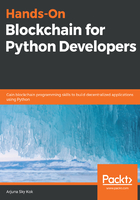
What this book covers
Chapter 1, Introduction to Blockchain Programming, teaches the story of Bitcoin and what makes Bitcoin so valuable. You will learn the underlying technology that empowers Bitcoin, which is Blockchain technology. Also, you will learn why Ethereum was created in the first place.
Chapter 2, Smart Contract Fundamentals, shows the differences between traditional programs and smart contracts. You will see what flaws a traditional program has, and why a smart contract has the potential to overcome the flaws. You'll also see where smart contracts are being utilized nowadays.
Chapter 3, Implementing Smart Contracts Using Vyper, teaches you how to write a smart contract by using the Vyper programming language (which resembles Python). You will learn a number of important features of the Vyper programming language.
Chapter 4, Interacting with Smart Contracts Using Web3, shows you how to install the web3.py library, how to interact with a smart contract, and how to deploy a smart contract.
Chapter 5, Populus Development Framework, shows you how to use the Populus development framework and recognize its value to developers.
Chapter 6, Building a Practical Decentralized Application, teaches you how the web3.py library and Populus development framework are used to build a decentralized application.
Chapter 7, Frontend Decentralized Application, shows you how to build a Twitter-like decentralized application with a desktop frontend.
Chapter 8, Creating Token in Ethereum, teaches you how to create your own token. It is a hands-on learning guide on launching your own cryptocurrency.
Chapter 9, Cryptocurrency Wallet, shows you how to build an Ethereum wallet with a desktop frontend.
Chapter 10, InterPlanetary – A Brave New File System, is an introduction to the InterPlanetary File System, where people can store distributed files. In blockchain, storage is expensive. It is already prohibitive to store an image file (never mind a video file) on the blockchain. IPFS is a new technology designed to mitigate that problem. You will learn what IPFS is, and the state this technology is in at this very moment.
Chapter 11, Using ipfsapi to Interact with IPFS, teaches you how to use the Python library to connect to an IPFS node.
Chapter 12, Implementing a Decentralized Applications Using IPFS, shows you how to implement a decentralized video-sharing application that utilizes IPFS technology.